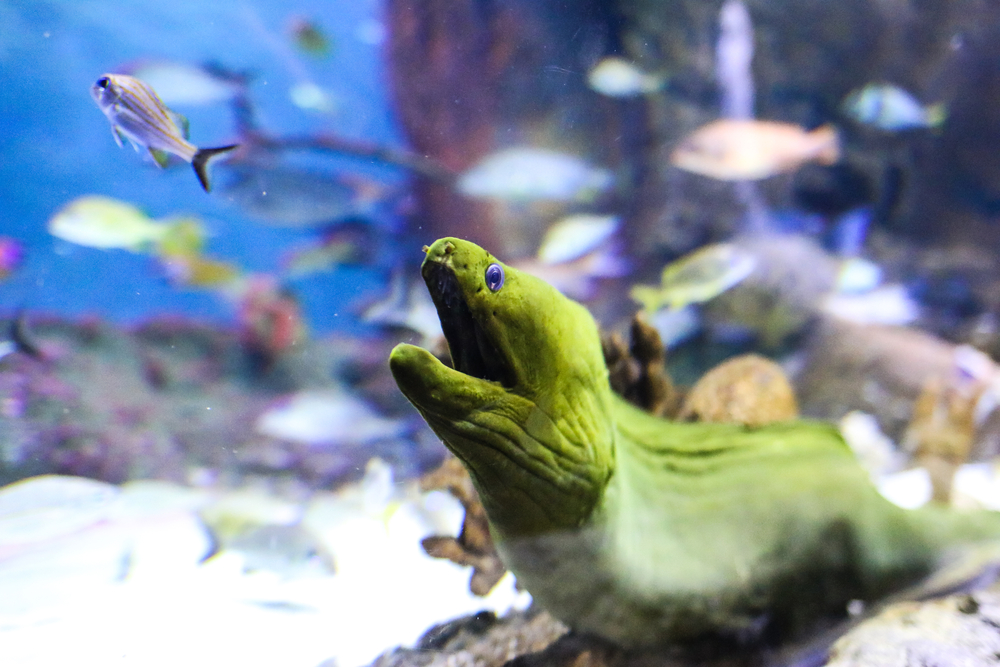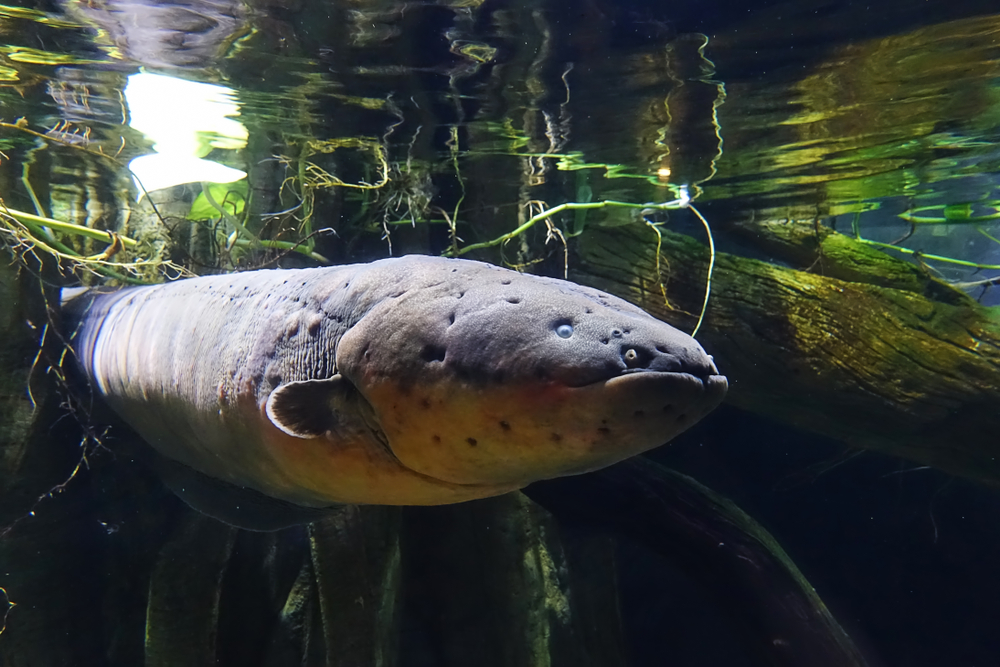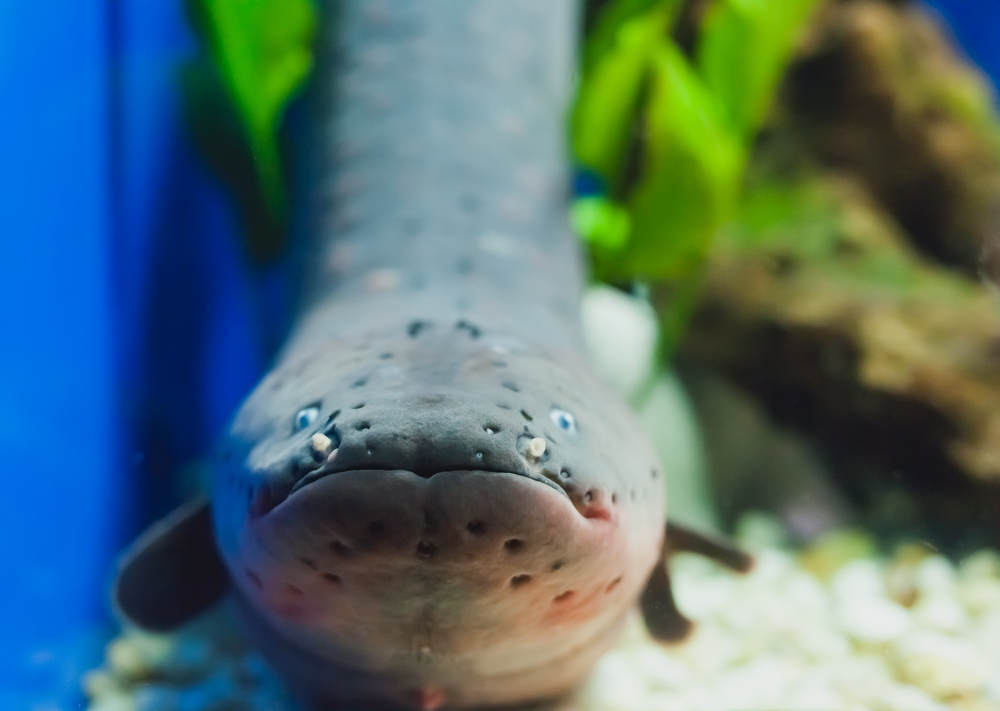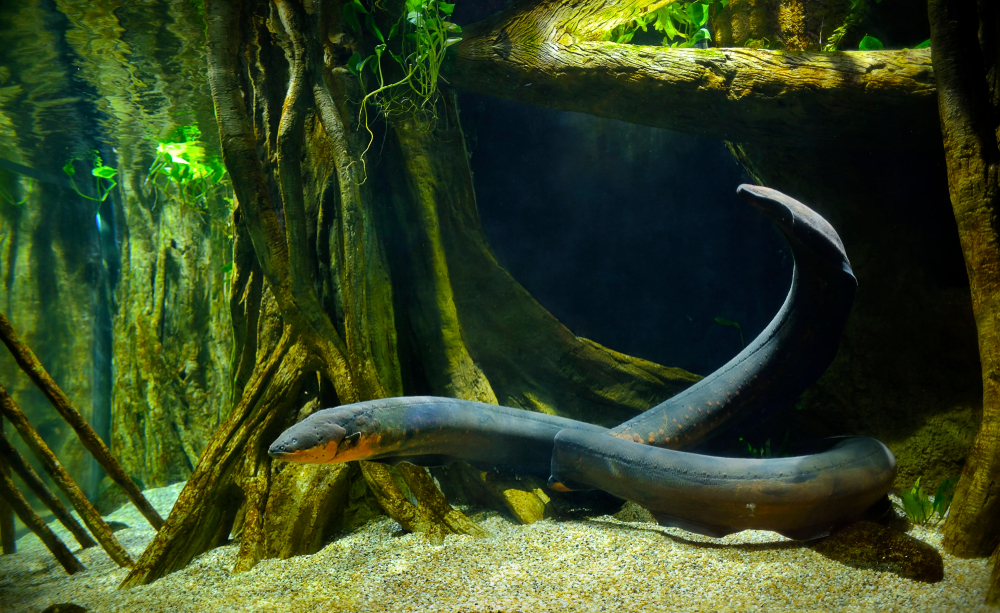About
The Electric Eel, scientifically known as Electrophorus electricus, is a species of electric fish belonging to the Animal Kingdom’s class Actinopterygii and order Gymnotiformes. This order also includes other electric fish species such as the electric catfish. Native to the freshwater habitats of the Amazon and Orinoco river basins in South America, the Electric Eel is famous for its unique ability to generate electric shocks.
Despite its name, the Electric Eel is not a true eel but rather a knifefish, possessing an elongated, serpentine body that can grow up to 2.5 meters in length. It has a scaleless body that varies in coloration from dark gray to brownish-black. Electric Eels have specialized organs called electrocytes that allow them to produce electric discharges for hunting prey, communicating, and self-defense.
These electric discharges are produced through a process called electrogenesis, where the Electric Eel can generate bursts of high-voltage electricity of up to 600 volts. This electric shock can stun or incapacitate prey, allowing the Electric Eel to feed on small fish and invertebrates. Additionally, Electric Eels use their electric organ discharges to navigate murky waters and detect potential threats.
Conservation Needs and Status
While the Electric Eel is not currently assessed for conservation status on the International Union for Conservation of Nature (IUCN) Red List, its population may face threats from habitat degradation, pollution, and overfishing in some areas of its range. Additionally, habitat destruction and deforestation along riverbanks can impact the availability of suitable habitats for Electric Eels.
Conservation efforts aimed at protecting the Amazon and Orinoco river basins, as well as implementing sustainable fisheries management practices, are essential for ensuring the long-term survival of Electric Eel populations. Public education and awareness about the ecological importance of these unique fish species and the conservation of freshwater ecosystems are also crucial for promoting their conservation. Continued research and monitoring are necessary to assess population trends and implement effective conservation measures to safeguard the Electric Eel and its habitat.
Physical Characteristics
The Electric Eel (Electrophorus electricus), despite its name, is not actually an eel but belongs to the knifefish family. It is native to the murky freshwater environments of the Amazon and Orinoco river basins in South America. The electric eel is renowned for its ability to generate powerful electrical charges, used for navigation, communication, and defense against predators or to stun prey.
Size and Weight:
- Length: Electric eels can grow quite large, typically reaching lengths of 6 to 8 feet (1.8 to 2.4 meters), with some reports of individuals extending up to 10 feet (about 3 meters).
- Weight: They weigh approximately 44 pounds (20 kilograms), though larger specimens can exceed this average.
Physical Characteristics:
- Body Shape: Electric eels have a long, cylindrical body that resembles that of a traditional eel. Their shape is streamlined, facilitating movement through dense, aquatic vegetation and muddy waters.
- Coloration: Their color varies from dark greenish-brown on the back to a yellowish or orange hue on the belly. This coloration helps them blend into the riverbed environment, providing camouflage against predators and prey alike.
- Skin: The skin of the electric eel is thick and lacks scales, covered in a slimy mucus that aids in conducting electricity. This unique skin is crucial for their survival, as it helps protect them from their own electric discharges as well as those of other electric eels.
- Electric Organs: The most distinctive feature of the electric eel is its electric organs – the Main, Hunter’s, and Sachs’ organs – which occupy a significant portion of its body. These organs contain electric cells capable of producing electrical discharges of up to 600 volts and 1 ampere of current, making the electric eel one of the most potent bioelectricity generators.
- Mouth and Gills: The mouth of the electric eel is located at the end of its snout and is relatively small compared to its body size. It breathes air, requiring it to surface approximately every 10 minutes. The gill opening is small, located just behind the head, and is used primarily for the eel’s minimal gill respiration.
- Tail: The tail of the electric eel is long and comprises much of its body length, providing propulsion and maneuverability in the water. The tail is also where two of the main electric organs are located, contributing to its ability to generate electrical charges.
The Electric Eel’s unique combination of physical and biological characteristics, including its remarkable electric organs, makes it one of the most fascinating creatures in the aquatic world. Its ability to generate electricity not only defines its place in the natural world but also underscores the incredible diversity of life forms and survival strategies in the animal kingdom.
Reproduction
The reproductive cycle of the electric eel, a unique species known for its ability to generate electric shocks, is intriguing and essential for its species’ continuation. Here’s an overview:
Breeding Season: Electric eels do not have a well-defined breeding season but may exhibit increased reproductive activity during the wet season when water levels rise and food availability improves.
Courtship and Mating: Little is known about the courtship behavior of electric eels, but mating likely involves male-female interactions facilitated by chemical and possibly electrical signals.
Spawning: Electric eels are not true eels but are air-breathing fish. They reproduce through external fertilization, with females releasing eggs into the water column, followed by males releasing sperm to fertilize them.
Egg Development: After fertilization, the eggs develop externally in the water. The exact duration of egg development varies depending on environmental conditions such as temperature and water quality.
Hatching: Once the eggs hatch, the larvae emerge and begin their journey as transparent, ribbon-like creatures. They gradually develop into juveniles over time.
Growth and Maturation: Juvenile electric eels undergo rapid growth and development, fueled by a diet of small invertebrates and fish. As they mature, they acquire their iconic ability to generate electric shocks.
Reproductive Maturity: Electric eels reach sexual maturity at around 4 to 7 years of age, depending on various factors such as diet, water quality, and habitat conditions.
Population Dynamics: The reproductive success of electric eels is crucial for maintaining viable populations in their freshwater habitats. Environmental factors such as habitat degradation, pollution, and overfishing can impact their reproductive success and overall population health.
Conservation Implications: Understanding the reproductive cycle of electric eels is essential for their conservation and management. Conservation efforts focus on preserving their freshwater habitats, minimizing anthropogenic disturbances, and implementing measures to mitigate threats such as habitat destruction and pollution to ensure the long-term survival of this remarkable species.
Lifespan
The electric eel, a species of knifefish native to South America, is known for its ability to generate electric shocks for hunting prey and self-defense. Here’s an overview of their lifespan and threats to their life:
Wild Lifespan: In the wild, electric eels have a lifespan that typically ranges from 10 to 15 years, although some individuals may live longer under favorable conditions. Their lifespan in the wild is influenced by various factors, including predation, habitat quality, water quality, and availability of prey.
Lifespan in Captivity: Electric eels are occasionally kept in captivity in specialized aquariums or research facilities. In captivity, they may have access to consistent food, suitable water conditions, and veterinary care, which can potentially extend their lifespan beyond what is typical in the wild. However, there is limited data on their lifespan in captivity compared to their wild counterparts.
Threats to Electric Eels:
- Habitat Loss and Degradation: Electric eels inhabit freshwater rivers, streams, and swamps in South America, where they are susceptible to habitat loss and degradation due to deforestation, dam construction, pollution, and agricultural runoff. Loss of suitable habitat can fragment populations and limit their ability to find food, breed, and disperse.
- Overfishing: Electric eels are sometimes caught incidentally in fishing gear or intentionally targeted for their electric organs, which are used in traditional medicine and folk remedies. Overfishing can reduce their populations and disrupt their ecological role as predators in freshwater ecosystems.
- Pollution: Pollution from agricultural runoff, industrial discharge, and mining activities can contaminate the waterways inhabited by electric eels, affecting their health, reproductive success, and overall survival. Chemical pollutants such as heavy metals, pesticides, and toxins can accumulate in their tissues and disrupt physiological functions.
- Disease: Electric eels may be susceptible to diseases and parasites that can impact their health and vitality. Stressors such as habitat degradation, pollution, and captivity can weaken their immune systems and make them more vulnerable to infections and diseases.
- Climate Change: Climate change-related impacts such as changes in water temperature, precipitation patterns, and habitat availability can affect the distribution, behavior, and reproductive success of electric eels. Shifts in their environment may require them to adapt to new conditions or face increased competition and predation.
Conservation efforts for electric eels include habitat restoration, water quality management, regulation of fishing practices, public education on the importance of freshwater ecosystems, and research on their biology and ecology to inform conservation strategies. Protecting the habitats of electric eels benefits not only this species but also the many other organisms that depend on healthy freshwater ecosystems for their survival.
Eating Habits
The electric eel is a carnivorous predator with a diet primarily consisting of:
- Fish: Fish constitute the main source of food for electric eels. They prey on a variety of fish species, including small fish such as tetras, catfish, and characins, as well as larger species like knifefish and other electric eels.
- Invertebrates: In addition to fish, electric eels may also consume invertebrates such as crustaceans, insects, and small amphibians when available. These prey items supplement their diet and provide additional sources of nutrients.
Foraging Behavior: Electric eels employ specialized hunting techniques to locate and capture their prey:
- Electrolocation: One of the most remarkable aspects of electric eel feeding behavior is their ability to generate electric fields to detect prey. They produce weak electric pulses, which they emit into the surrounding water. When prey items disturb these electric fields, the eels can detect the disturbances and pinpoint the location of their prey, even in murky or dark water.
- Ambush Predation: Electric eels are ambush predators, lying in wait for unsuspecting prey to come within striking distance. Once they detect prey using electrolocation, they rapidly close in and immobilize their prey with a powerful electric shock emitted from specialized electric organs located along their bodies.
Prey Preferences: While electric eels primarily feed on fish, their prey preferences may vary depending on factors such as prey availability, habitat characteristics, and individual feeding behavior. They may target specific fish species based on size, behavior, and vulnerability to electric shocks.
Other Considerations:
- Electric eels have a high metabolic rate and require a substantial amount of food to meet their energy needs. They may consume prey equivalent to a significant portion of their body weight to sustain their energy demands.
- Feeding behavior in electric eels is influenced by environmental factors such as water temperature, seasonal changes, and prey abundance. They may adjust their foraging strategies and diet composition in response to these environmental cues.
- The electric eel’s ability to generate powerful electric shocks not only aids in prey capture but also serves as a means of self-defense against potential predators.
- Conservation efforts aimed at protecting the freshwater habitats where electric eels reside are essential for ensuring the continued availability of prey resources and maintaining healthy populations of this fascinating species.
Uniqueness
The Electric Eel, scientifically known as Electrophorus electricus, is one of the most fascinating creatures in the aquatic world, renowned for its ability to generate powerful electrical charges. This remarkable ability sets it apart from almost all other aquatic organisms. Here are some key aspects that make the Electric Eel unique:
Electrical Generation: Electric Eels possess specialized cells called electrocytes that are capable of generating electric shocks. These eels can produce up to 600 volts of electricity, which they use for hunting, self-defense, and navigation. This voltage is powerful enough to stun prey and deter predators.
Long, Snake-like Body: Despite its name, the Electric Eel is not actually an eel but a type of knifefish. It has a long, cylindrical body that can grow up to 2.5 meters (8 feet) in length, and it lacks pelvic fins. Its appearance and serpentine movement resemble those of true eels, which is how it got its name.
Breathing Air: Electric Eels are obligate air-breathers, meaning they need to come to the surface to breathe air. Approximately every 10 minutes, they will rise to the surface to gulp air, which allows them to inhabit waters that are low in oxygen where other predators may not be able to survive.
Habitat: They are found in the murky streams and ponds of the Amazon and Orinoco basins of South America. Their ability to generate electricity allows them to be dominant predators in these environments, despite the low visibility.
Hunting and Communication: The electric charges are not only used for defense but also play a crucial role in how these animals hunt and communicate. They emit low-level electric currents to locate and identify objects around them in a process similar to echolocation.
Unique Breeding Behavior: The breeding behavior of the Electric Eel is also notable. During the dry season, the male creates a nest from his saliva into which the female lays her eggs. As many as 17,000 eggs can be laid, and the male guards the nest aggressively.
Conservation Status: While not currently listed as endangered, Electric Eels are subject to the pressures of habitat destruction and the exotic pet trade. Understanding and preserving their natural habitat is crucial for their continued survival.
Scientific Interest: Beyond their natural intrigue, Electric Eels have been the subject of scientific study for understanding bioelectrogenesis (the generation of electricity by living organisms) and have potential applications in medical and technological fields.
The Electric Eel’s ability to generate significant amounts of electricity, its unique respiratory needs, and its adaptation to low-oxygen environments make it a truly unique species within the aquatic world. Its presence highlights the incredible diversity and adaptation of life forms in freshwater habitats of South America.
Related Family Species
Sources
- Britannica, Electric Eel, https://www.britannica.com/animal/Electrophorus-fish-genus, retrieved March 2024.
- Burnie, David & Wilson, Don, Animal, Smithsonian Institute, Washington DC.
- Hickman et al, Integrated Principle of Zoology, McGraw Hill, Boston.





































































